The fuel system of the engine consists of a fuel tank, a fuel module, pipelines and a fuel rail with injectors
The engine air supply system consists of an air filter, air ducts and a throttle assembly
The fuel vapor recovery system consists of an adsorber, an adsorber purge valve and connecting pipes
The evaporative emission system serves only to meet environmental requirements to reduce toxicity.
The purpose of the fuel supply system is to ensure that the required amount of fuel is supplied to the engine in all operating modes.
The engine is equipped with an electronic control system with multiport fuel injection.
In the distributed injection system, the functions of mixture formation and dosing of the air-fuel mixture supply to the engine cylinders are separated:
Air is supplied by an air supply system consisting of a throttle assembly and an idle speed controller, and the amount of fuel required at each moment of engine operation is injected by nozzles into the cylinder head.
This control method makes it possible to ensure the optimal composition of the combustible mixture at each particular moment of engine operation, which allows you to get maximum power with the lowest possible fuel consumption and low exhaust gas toxicity.
The fuel injection system (as well as the ignition system) is controlled by an electronic unit that continuously monitors the engine load, the vehicle speed, the thermal state of the engine, and the optimal combustion process in the engine cylinders using appropriate sensors.
A feature of the Hyundai Solaris injection system is the synchronous operation of the injectors in accordance with the valve timing (the engine control unit receives information from the phase sensor).
The control unit turns on the injectors in series, not in pairs, as in asynchronous injection systems.
Each nozzle is activated through 720° crankshaft rotation.
In starting and dynamic modes of engine operation, an asynchronous method of fuel supply is used without synchronization with the rotation of the crankshaft.
The main sensor for ensuring an optimal combustion process is the control sensor for the oxygen concentration in the exhaust gases (lambda probe).
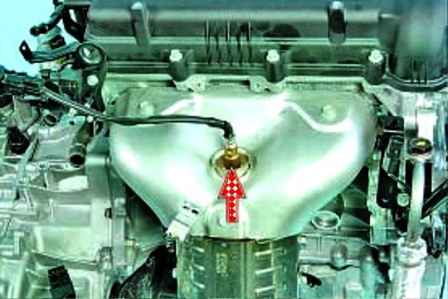
It is installed in the collector and, together with the engine control unit and injectors, forms a control loop for the composition of the air-fuel mixture supplied to the engine.
Based on the sensor signals, the engine control unit determines the amount of unburned oxygen in the exhaust gases and, accordingly, evaluates the optimal composition of the air-fuel mixture entering the engine cylinders at any given time.
Having fixed the deviation of the composition from the optimal 1:14 (fuel / air), which ensures the most efficient operation of the exhaust gas catalytic converter, the control unit changes the composition of the mixture using injectors.
Since the oxygen concentration sensor is included in the feedback circuit of the engine control unit, the air-fuel ratio control loop is closed.

A feature of the engine management system of a Hyundai Solaris car is the presence, in addition to the control sensor, of a second, diagnostic oxygen concentration sensor installed at the outlet of the catalytic converter of the exhaust gas system.
By the composition of the gases that have passed through the converter, it determines the efficiency of the engine control system.
If the engine control unit, based on information received from the diagnostic oxygen concentration sensor, detects an excess of exhaust gas toxicity that cannot be eliminated by calibrating the control system, then it turns on the engine malfunction indicator in the instrument cluster and stores an error code in memory for subsequent diagnostics.
The fuel tank is steel, stamped, installed under the floor of the body in its rear part and attached to the body with two clamps.

In order to prevent fuel vapors from entering the atmosphere, the tank is connected by a pipeline to the adsorber system we are evaporative.
The fuel pump module is installed in the fuel tank flange hole.
From the fuel module, fuel is supplied to the fuel rail mounted on the cylinder head. From the fuel rail, fuel is injected by injectors into holes in the cylinder head.
A special tube is inserted into the fuel tank pipe to connect it to the filling pipe, at the end of which there is a valve that is constantly closed and prevents fuel from flowing out when the vehicle rolls over.
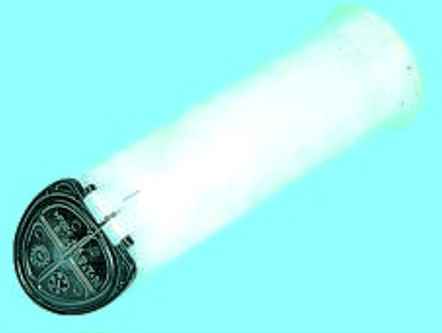
The valve closes under the action of a spring installed underneath.
Under the pressure of the fuel entering the tank during refueling, the valve opens and passes the fuel.
The fuel lines of the power supply system are tubes connecting various elements of the system.
The hoses of the power system are made using a special technology from oil and petrol resistant materials.
The use of hoses other than those recommended may result in power failure and in some cases a fire.
The fuel module includes an electric pump, a fuel pressure regulator, coarse and fine fuel filters and a fuel gauge sensor.
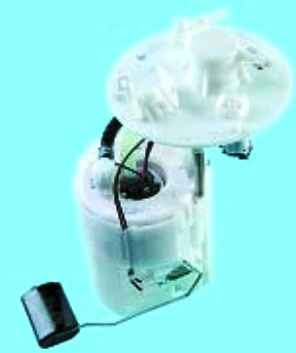
The fuel module provides fuel supply and is installed in the fuel tank, which reduces the likelihood of vapor locks, since the fuel is supplied under pressure, and not due to vacuum.
In addition, lubrication and cooling of the fuel pump parts are improved.
Submersible fuel pump, rotary type, with electric drive.
The fuel pressure regulator is installed in the fuel module and is designed to maintain a constant fuel pressure in the fuel rail.
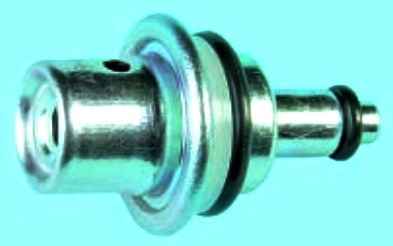
The regulator is connected to the beginning of the supply line (immediately after the fuel filter) and is a bypass valve with a spring, the force of which is strictly calibrated.
Fuel rail 1 is a hollow part with holes for injectors 2 and brackets 4 for fastening to the cylinder head.

The injectors are sealed in the openings of the ramp and in the openings of the cylinder head with rubber rings and secured with spring clips 3.
The rail assembly with injectors is inserted with injector shanks into the holes of the cylinder head and secured with two bolts.
The injectors are attached to the rail from which fuel is supplied to them, and with their nozzles they enter the holes in the cylinder head.

The injectors are sealed with rings 1 and 3 in the openings of the rail and cylinder head.
The injector is designed for metered injection of fuel into the engine cylinder and is a high-precision electromechanical valve.
Fuel under pressure flows from the rail through the channels inside the nozzle body to the shut-off valve.
A spring compresses the check valve needle against the taper hole in the atomizer plate, keeping the valve in the closed position.
The voltage supplied from the engine control unit through plug-in terminals 2 to the injector solenoid winding creates a magnetic field in it, which draws the core together with the shut-off valve needle into the solenoid.
A conical annular hole in the atomizer plate opens and fuel is injected through the diffuser of the atomizer body into the inlet port of the cylinder head and further into the engine cylinder.
After the electrical impulse stops, the spring returns the core and needle of the shut-off valve to its original position New state - the valve is closed.
The amount of fuel injected by the injector depends on the duration of the electric pulse.
The air filter is installed in the left side of the engine compartment.
The filter is connected by an air supply hose to the throttle assembly.
The filter element of the air filter is paper, flat, with a large area of the filtering surface.
Throttle assembly is the simplest control device and serves to change the amount of main air supplied to the engine intake system.
It is installed on the inlet flange of the intake pipe.
An air supply sleeve is put on the inlet pipe of the throttle assembly, fixed with a clamp and connecting the throttle assembly with the air filter.

In housing 1, a damper 2 that rotates on an axis is installed.
A throttle position sensor and an idle speed control are built into the throttle body. The node itself is non-separable.
There is no seasonal adjustment device in the air filter, so the throttle assembly is equipped with a heating system that prevents icing of the throttle valve in the cold season and is connected to the engine cooling system with hoses.
During operation, the throttle assembly does not require maintenance and adjustment, only monitor the condition of the rubber seals to avoid air leakage.
The engine control unit, having processed the signals from the sensors, determines the need to open the regulator valve and transmits impulses to the output of the regulator stator winding.
With each control pulse, the rotor rotates through a certain angle, moving the regulator valve relative to the seat with the lead screw.
Additional air enters the intake pipe through channels in the throttle assembly.
Determining the vacuum in the engine intake pipe, the control unit seeks to maintain it at a given level by periodically opening and closing the idle air control valve, thereby providing a constant amount of additional air to maintain a constant crankshaft speed at idle.
By changing the opening and closing of the regulator valve, the control unit compensates for a significant increase or decrease in the amount of air supplied, caused by its suction through a leaky intake system or, conversely, by a clogged air filter.
The inclusion of additional units causes an increase in engine load, accompanied by a decrease in the idle speed of the crankshaft and a change in the vacuum in the intake pipe, which is also compensated by the control unit using the regulator.
Checking fuel pressure
The main criterion for the health of the engine power system is the fuel pressure in the fuel rail.
In case of insufficient fuel pressure, the following are possible:
- – unstable engine operation;
- – stop the engine at idle;
- - increased or decreased idle speed of the crankshaft;
- - insufficient throttle response of the car (the engine does not develop full power);
- - jerks and dips in the engine when the car is moving;
First, we recommend checking the reliability of the electrical contacts in the wiring harness blocks of the injection system components responsible for supplying fuel (fuel pump, injectors).
Checking the fuel pressure in the fuel system is possible only if there is a pressure gauge with a hose for connecting to the fuel line.
Turn on the ignition and listen: within a few seconds you should hear the sound of the electric fuel pump.
If you can't hear it, check the pump's electrical circuit.
Keep in mind that the electric fuel pump does not turn on if there is pressure in the fuel supply system.
In other words, if you previously turned on the ignition and tried to start the engine, then a serviceable electric fuel pump should have already created pressure in the system, so the absence of sound from the operation of the electric fuel pump in this case is not a malfunction.
Reduce the pressure in the supply system
Remove the two nuts securing the fuel supply line to the fuel rail and remove the pipe fitting from the fuel rail studs.
To check the fuel pressure, connect a pressure gauge with a measurement range of at least 500 kPa (5 kgf/cm2) between the fuel supply line and the fuel rail.
With the engine idling, the pressure in the fuel line must be at least 345 kPa (3.45 kgf/cm2).
The following reasons for low fuel pressure are possible:
- faulty fuel pressure regulator (installed in the fuel module);

- the fine filter is clogged ...
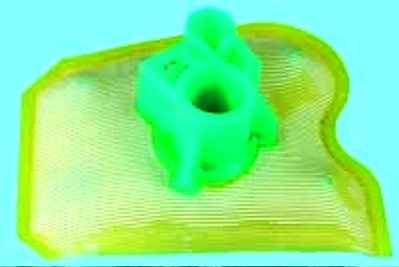
- or coarse fuel filter;
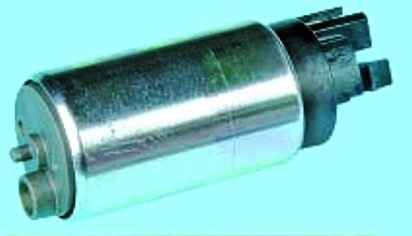
- the electric fuel pump is faulty.
Stop the engine and reduce the pressure in the fuel system
Disconnect the pressure gauge from the fuel supply line and fuel rail fitting.
Connect the fuel supply line to the fuel rail fitting.
Relieve pressure in the fuel system
The fuel in the supply system is under high pressure, so it is forbidden to loosen the fuel line connections while the engine is running or immediately after it has stopped.
To carry out work on the repair of the power supply system on a just stopped engine, it is necessary to first reduce the pressure in the power supply system.
Turn off the ignition, open the hood and place it on the stop.
Disconnect the wire from the negative terminal of the battery.
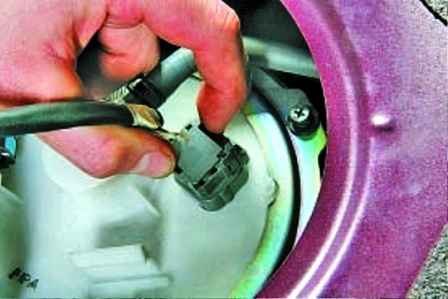
Disable the fuel pump by disconnecting the wiring harness connector from it
Connect the wire to the negative terminal of the battery, start the engine and let it run until the fuel rail runs out of fuel.
The engine will then stop.
Turn off the ignition. Now you can disconnect the fuel lines.





